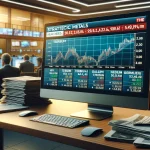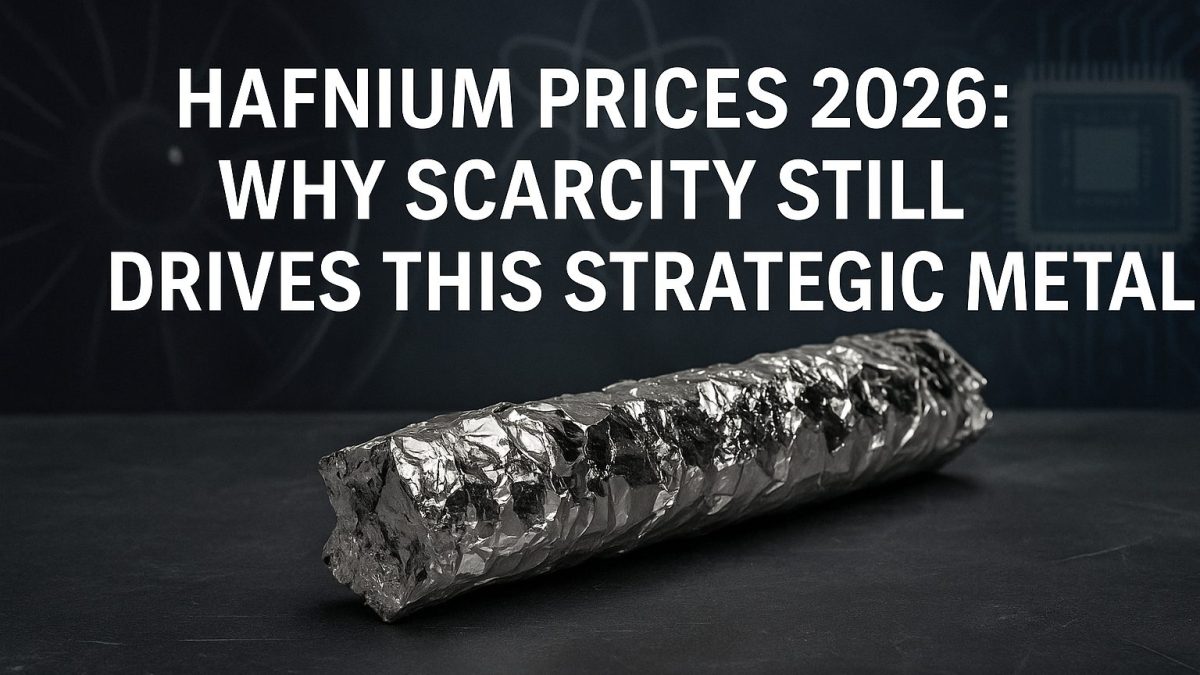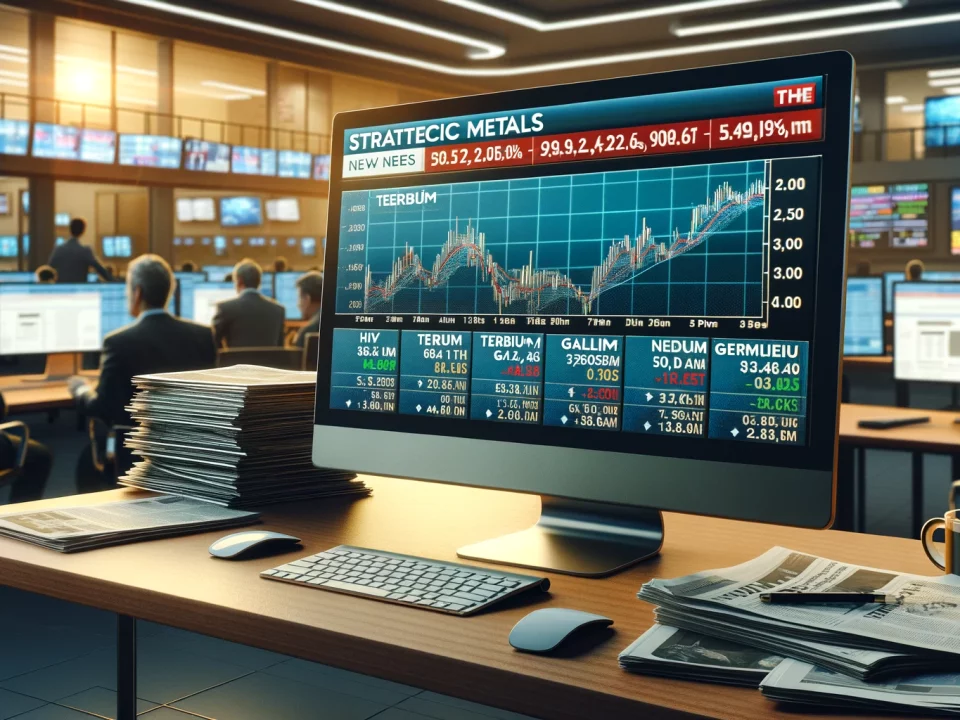
Weekly News Review September 8 – September 14 2025
September 14, 2025
Weekly News Review September 15 – September 21 2025
September 21, 2025Hafnium isn’t a household name, but in strategic metals circles it has long been considered one of the rarest and most fascinating markets. Used in superalloys for jet engines, nuclear reactor control rods, and advanced semiconductor technology, hafnium sits quietly at the intersection of energy, defense, and high-tech.
And yet, it is never mined in its own right. Hafnium is only recovered as a by-product of zirconium refining — meaning that for every 50 tonnes of zirconium produced, just 1 tonne of hafnium comes to market. This structural bottleneck has always kept the market tight, and it explains why demand swings, even small ones, can ripple into significant price action.
A Rare Metal With a Short History
Compared to copper or iron, hafnium is a relative newcomer. It was only identified in 1923 by Dirk Coster and George de Hevesy in Copenhagen, making it the last stable element to be discovered. Its name comes from “Hafnia,” the Latin word for the city.
Despite its late discovery, hafnium quickly found critical roles in modern technology. Its resistance to corrosion, high melting point, and ability to absorb neutrons made it indispensable for nuclear energy. Over time, aerospace and semiconductor applications expanded demand further, locking hafnium into the fabric of 20th- and 21st-century innovation.
Supply: Scarcity by Design
The global hafnium supply chain is unusual. Unlike many other metals, there are no dedicated hafnium mines. Production is entirely tied to zirconium refining, which is concentrated in a handful of countries — primarily Australia, South Africa, China, Brazil, Russia, and Ukraine.
This by-product dependency means hafnium supply is effectively capped by zirconium demand, which is itself driven by nuclear energy and ceramics. Even if demand for hafnium surges, production cannot easily scale. That is why the market remains inherently tight, with little slack for disruption.
The numbers illustrate the point: for every 50 tonnes of zirconium, just 1 tonne of hafnium emerges. When demand jumps, there is no lever to quickly turn up production. That’s why prices can spike dramatically, even when global volumes are measured in just a few hundred tonnes.
Price Trends: Peaks and Rebounds
We saw this dynamic play out in recent years. In October 2023, our internal price feed recorded hafnium peaking at $5,488.90/kg — a stark reminder of just how fast the market can tighten when supply and demand get out of balance.
Prices eased during 2024, reflecting softer global conditions, but 2025 has already brought signs of renewed strength. At the time of writing, hafnium sits at around $4,730/kg — comfortably above pre-2022 levels. The rebound highlights how sensitive this market remains to even modest shifts in nuclear, aerospace, or semiconductor demand.
Demand Drivers: Nuclear, Aerospace, and Semiconductors
Nuclear Energy
Hafnium’s ability to absorb neutrons makes it a vital material in nuclear reactors, where it is used in control rods to regulate chain reactions. With many governments extending the lifespan of existing reactors and several new builds underway, nuclear provides a steady foundation for hafnium demand. The recent resurgence of nuclear power as a “clean” energy source further strengthens this outlook.
Aerospace and Defense
Superalloys are another major consumer. Hafnium, when alloyed with nickel, cobalt, or iron, significantly improves high-temperature resistance. This makes it essential in jet engine turbine blades, rocket nozzles, and other aerospace components. As global defense budgets rise and commercial aircraft build rates recover post-pandemic, hafnium consumption in this sector is expected to climb steadily.
Semiconductor Technology
Perhaps the most exciting growth driver lies in semiconductors. Hafnium-based compounds, such as hafnium oxide, are used as insulators in advanced microchips. Without them, processors would be slower and less efficient. With the global push for AI, 5G, and ever-faster computing, this application ensures that hafnium remains at the cutting edge of technology demand.
Growth Projections
External analysts, including Fortune Business Insights, forecast hafnium demand to grow at a mid- to high-single digit CAGR through the 2030s. For such a small and inflexible market, this growth trajectory is enough to keep prices well supported.
The bottom line is simple: hafnium does not need explosive demand growth to tighten. Even steady, incremental increases are enough to outpace constrained supply.
Investment Relevance
For private investors, hafnium’s story illustrates why scarcity matters. Unlike traditional commodities where new mines can scale production, hafnium remains locked behind zirconium output. Until new multi-metal projects, such as ASM’s Dubbo Project in Australia, come online, the supply picture will remain constrained.
That scarcity makes hafnium a compelling diversification play. It behaves independently of traditional asset classes, offering resilience against inflation and market downturns. As part of a balanced portfolio of strategic metals, hafnium can provide exposure to sectors — nuclear, aerospace, and semiconductors — that are likely to define the next decade of industrial growth.
Outlook for 2025–2026
Looking ahead, we expect the hafnium market to remain tight but balanced, with a bullish tilt. Modest but consistent demand growth will meet inelastic supply, keeping average prices elevated well above pre-2022 levels.
Upside risks include:
- Faster nuclear capacity additions.
- Accelerated aircraft build rates or defense spending.
- Stronger-than-expected semiconductor cycles.
Downside risks could emerge from:
- A macroeconomic slowdown.
- Substitution in certain nuclear applications.
- A faster-than-expected ramp-up in by-product supply.
But on balance, hafnium’s scarcity by design continues to support its case as one of the rarest and most strategically important metals in the world.
Conclusion
Hafnium may not make daily headlines, but its importance to critical industries is undeniable. With constrained supply, diverse demand, and a proven ability to spike in price, this “quiet” metal deserves attention from forward-looking investors.
👉 To explore current price trends and our full analysis, visit our Hafnium Prices & Forecast page.






